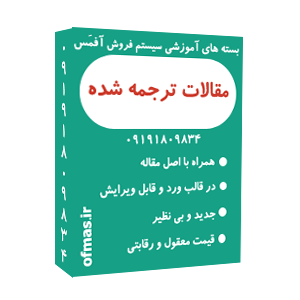ترجمه مقاله مدلسازی اسپین و سایر آثار کوآنتوم در پلاسماها در 35 صفحه فارسی ورد قابل ویرایش با فرمت doc به همراه اصل مقاله انگلیسی
عنوان فارسی :
مدلسازی اسپین و سایر آثار کوآنتوم در پلاسماها
عنوان انگلیسی :
Modelling of spin and other quantum effects in plasmas
تعداد صفحات فارسی : 35 صفحه ورد قابل ویرایش
سطح ترجمه : متوسط
شناسه کالا : y2050
دانلود رایگان مقاله انگلیسی : http://ofmas.ir/dlpaper/y2050.pdf
دانلود ترجمه فارسی مقاله : بلافاصله پس از پرداخت آنلاین 42 هزار تومان قادر به دانلود خواهید بود .
بخشی از ترجمه :
چکیده
توسعه ی مکانیک کوانتوم در طول قرن بیستم ،راه کاملا جدیدی از توصیف علم فیزیک را موجب شد. تفسیر تئوری کوانتوم ذاتا دشوار است:برای نمونه، سیستم های بدنه- بسیاری از طریق یک ماتریس چگالی معروف توصیف میشوند که دارای شباهت صریحی در تئوری کلاسیک نیست.با این حال، در اثر ویگنر 30 یک شیوه ی جایگزین برای توصیف سیستم های بدنه- بسیاری با استفاده از کارکرد توزیع شبه –احتمال ارائه شد.این بین نظریه ی جنبشی کوانتوم و کلاسیک اتصال آشکارتری ایجاد نمود.این تز در زمینه ی مدلسازی اثرات کوانتوم در پلاسماها است.این تاکید بر روی توصیف پلاسماهایی متمرکز است که حاوی ذرات 2/1-اسپین (چرخش) هستند.برای این منظور، مدلهای جدید بر اساس نظریه ی جنبشی کوانتوم، استنتاج شد.این شیوه با شروع از معادله ی تکامل برای ماتریس چگالی و بکارگیری تبدیل ویگنر برای درجه ی موقعیت آزادی و تبدیل –Q برای اسپین حاصل میشود.مشخصات (ویژگیهای) نظریه ی جنبشی حاصل ،آنگاه مورد بررسی قرار میگیرد و تامین معیار ضروری اساسی نشان داده میشود همانند بقای انرژی.معادله (برابری) جنبشی آنگاه برای استنتاج یک نظریه ی فلوئیدی برای ذرات 2/1-اسپین بکار میرود.
در این تز، مدلهای جنبشی و سیال برای مشکلات مختلف در فیزیک پلاسمای کوانتوم بکار میروند.برای نمونه، نشان داده خواهد شد اصلاح الکترودینامیک کوانتوم برای فاکتور –g الکترون میتواند یک حالت موج را موجب شود که دچار کمبود شباهت (آنالوگ) کلاسیک میشود و این اسپین ممکن است بر روی میزان میرایی موج های Alfvén اثر بگذارد.این مدلها هم چنین برای مشکلات غیر خطی بکار میرود و نشان داده خواهد شد که آنها موجب اصلاحات نیروی به اصطلاح پاندروموتیو (ponderomotive) اسپین میشوند.
Abstract
The development of quantum mechanics during the 20th century gave rise to a completely new way of describing physics. The interpretation of quantum theory is inherently difficult: for example, many-body systems are described by a so called density matrix which has no straightforward analogue in classical theory. However, in the 30’s Wigner proposed an alter- native way of describing many-body systems, using a quasi-probability distribution function. This made the connection between classical and quantum kinetic theory clearer. This thesis is concerned with modelling of quantum effects in plasmas. The focus lies on describing plasmas containing spin-1/2 particles. For this purpose, new models, based on quantum kinetic theory, are derived. This is achieved by starting from the evolution equation for the density matrix and applying a combination of the Wigner transformation for the position degree of freedom and the Q-transformation for the spin. The properties of the resulting kinetic theory are then investigated and it is shown to satisfy basic necessary criteriasuchasenergyconservation. Thekineticequationisthenusedtoderiveafluidtheory for spin-1/2 particles. In this thesis the kinetic and fluid models are applied to different problems in quantum plasma physics. For example it will be shown that the quantum electrodynamic correction to the electron g-factor can give rise to a wave mode which lacks classical analogue, and that spin may affect the damping rate of Alfvén waves. The models will also be applied to nonlinear problems and it will be shown that they give rise to modifications of the so called spin ponderomotive force.

 دسته :
دسته :